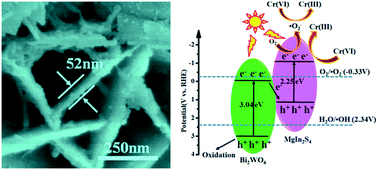Simple fabrication of Z-scheme MgIn2S4/Bi2WO6 hierarchical heterostructures for enhancing photocatalytic reduction of Cr(vi)†
Abstract
Direct Z-scheme MgIn2S4/Bi2WO6 hierarchical heterostructures were simply fabricated via immobilising MgIn2S4 nanoflakes onto the surface of Bi2WO6 hierarchical nanosheet-like structures towards photocatalytic reduction of Cr(VI). The analyses of the energy band structure, UPS tests and DMPO-ESR spin-trap experiments confirm that the intimate MgIn2S4/Bi2WO6 heterointerface allows an efficient Z-scheme interfacial charge migration route between MgIn2S4 and Bi2WO6, leading to higher redox ability of photoexcited carriers, and thus favours the separation of photoexcited carriers, proved by the results of PL spectroscopy, photoluminescence decay traces, transient photocurrent densities and EIS. In addition, the MgIn2S4/Bi2WO6 heterostructures also exhibit obviously enhanced ultraviolet-visible-light absorption according to UV-vis DRS analysis, and can generate more electron–hole pairs under UV-visible light illumination, effectively improving the photocatalytic activity. Therefore, because of their synergistic effects, all the MgIn2S4/Bi2WO6 hierarchical heterostructures show distinctly improved photoreduction activities for Cr(VI), compared with pure Bi2WO6. The optimal hybrid (MIS/BWO-0.35) displays nearly 100% Cr(VI) reduction into Cr(III) after 40 min of simulated sunlight illumination, which is better than the majority of the reported Bi2WO6 and other semiconductor photocatalysts before. Its reaction rate constant for the photoreduction of Cr(VI) (0.1063 min−1) is about 4.5 times higher than that of the pristine Bi2WO6 (0.0237 min−1). This work provides a valid approach for developing efficient Z-scheme photocatalytic materials in removing Cr(VI).



 Please wait while we load your content...
Please wait while we load your content...